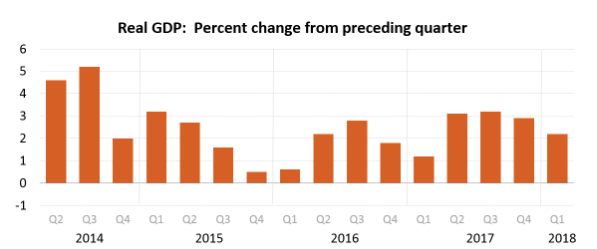The already-lower gross domestic product in the first quarter of 2018 was revised downward Wednesday after a downward revision in housing investment, according to the U.S. Bureau of Economic Analysis.
The second estimate revised GDP growth to 2.2% in the first quarter, down from 2.3% in the first estimate and from 2.9% in the fourth quarter.
Today’s GDP estimate is based on more complete source data than was available for the advance estimate issued last month.
The chart below shows this drop brings GDP back down from where it was hovering near 3%, however it still remains up from the drop to nearly 1% in the first quarter of 2017.
Click to Enlarge
(Source: BEA)
Real gross domestic income increased 2.8% in the first quarter, up from an increase of 1% in the fourth quarter. The average of real GDP and real GDI, a supplemental measure of U.S. economic activity that equally weights GDP and GDI, increased 2.5% in the first quarter, up from an increase of 2% in the fourth quarter.
The downward division was caused by a decrease in the housing sector as residential fixed investment fell in the second quarter.
The increase in real GDP in the first quarter reflected positive contributions from nonresidential fixed investment, personal consumption expenditures, exports, private inventory investment, federal government spending and state and local government spending. But these were partly offset by a negative contribution from residential fixed investment. Imports, which are a subtraction in the calculation of GDP, increased.
Here are updates to the previous estimate:
Current-dollar GDP: Decreased to 4.2%, down from last estimate’s 4.3%
Gross domestic purchases price index: Decreased to 2.7%, down from 2.8%
Personal consumption expenditures: Decreased to 2.6%, down from 2.7%
But despite these downward revisions, one expert explained the market will see a strong rebound in the second quarter.
“First-quarter GDP growth was revised down only trivially to 2.2% annualized in the second estimate, from 2.3%, but the incoming monthly data suggest that second-quarter GDP growth will be much stronger,” Capital Economics Chief Economist Paul Ashworth said. “Our current forecast is for a rebound in GDP growth to between 3% and 3.5%.”




